Pudding is a beloved dessert enjoyed by many, but when it comes to health, not all puddings are created equal. Some puddings are packed with sugar, unhealthy fats, and artificial additives, while others can be a healthier option. In this article, we will explore what makes a pudding healthy, discuss different types of puddings, and provide tips for making healthier versions of this sweet treat.
Understanding What Makes a Pudding Healthy
A healthy pudding should provide nutritional benefits without compromising taste. The key factors that determine the healthiness of a pudding include:
Lower sugar content: Excessive sugar intake is linked to various health issues such as obesity, heart disease, and type 2 diabetes. A healthier pudding should have a reduced sugar content, or be sweetened naturally with fruits, stevia, or other low-calorie alternatives.
High-quality fats: Some puddings contain unhealthy fats, like trans fats and saturated fats, which are detrimental to heart health. A healthier pudding should contain unsaturated fats from sources like nuts, seeds, or avocado.
Protein content: Adding protein to pudding can make it more filling and support muscle health. Puddings made with ingredients like Greek yogurt, chia seeds, or protein powder can provide this essential nutrient.
Fiber: Fiber helps with digestion and keeps you feeling full for longer. Puddings made with whole grains, fruits, or chia seeds tend to be higher in fiber.
Nutrient density: A nutritious pudding should also be rich in vitamins and minerals, such as calcium, vitamin D, and antioxidants, which support overall health.
Types of Healthy Puddings
There are various types of healthy puddings to choose from. Below, we’ll highlight some of the most popular and nutritious options.
1. Chia Pudding
Chia pudding is a great option for a healthy dessert. Chia seeds are packed with omega-3 fatty acids, fiber, protein, and essential minerals like calcium and magnesium. When mixed with liquid, chia seeds form a gel-like consistency, which makes them an ideal base for pudding.
To make chia pudding, mix chia seeds with a liquid like almond milk, coconut milk, or dairy milk. You can add a natural sweetener such as honey or maple syrup, and top the pudding with fresh fruits, nuts, or seeds for added flavor and nutrients.
Health Benefits of Chia Pudding:
- High in fiber, promoting good digestion.
- Rich in omega-3 fatty acids, which are good for heart health.
- A good source of plant-based protein.
- Low in sugar, especially when made with unsweetened milk and natural sweeteners.
2. Avocado Chocolate Pudding
Avocado is a versatile ingredient that can be used to make creamy, healthy puddings. In this case, avocado replaces heavy cream or butter, providing healthy fats without the unhealthy trans fats typically found in traditional puddings. Avocado’s smooth texture makes it perfect for pudding.
To make avocado chocolate pudding, blend ripe avocado with cocoa powder, a natural sweetener like maple syrup, vanilla extract, and a pinch of salt. The result is a rich, velvety chocolate pudding that’s not only delicious but also packed with heart-healthy monounsaturated fats.
Health Benefits of Avocado Chocolate Pudding:
- Provides healthy monounsaturated fats that support heart health.
- Rich in vitamins and minerals, such as potassium, vitamin E, and folate.
- Naturally low in sugar when made with minimal sweeteners.
- Contains antioxidants, especially when using dark cocoa powder.
3. Greek Yogurt Pudding
Greek yogurt is a nutritious ingredient that adds protein, calcium, and probiotics to your pudding. It can be used as a base for many pudding recipes, offering a creamy texture while providing a nutritional boost. Greek yogurt is naturally lower in sugar compared to regular yogurt, making it a healthier choice.
To make Greek yogurt pudding, simply mix Greek yogurt with a natural sweetener like honey or stevia, and add flavorings such as vanilla, cinnamon, or cocoa powder. You can also top the pudding with fresh fruits, granola, or nuts for extra texture and nutrients.
Health Benefits of Greek Yogurt Pudding:
- High in protein, supporting muscle repair and growth.
- Rich in probiotics, which promote gut health.
- Packed with calcium for bone health.
- Lower in sugar than many traditional puddings.
4. Coconut Milk Pudding
Coconut milk is another dairy-free alternative that can be used to make a creamy and delicious pudding. It’s a good source of medium-chain triglycerides (MCTs), a type of fat that may boost metabolism and promote fat burning. Coconut milk pudding can be flavored with vanilla, cinnamon, or chocolate for a variety of tastes.
To make coconut milk pudding, combine coconut milk with a natural thickener like agar-agar or cornstarch. Sweeten with stevia, honey, or maple syrup, and add any desired flavorings. This pudding is a great option for those who are lactose intolerant or following a dairy-free diet.
Health Benefits of Coconut Milk Pudding:
- Contains MCTs, which may support weight management and energy.
- Dairy-free and suitable for those with lactose intolerance or vegans.
- Can be made with minimal sugar, depending on the sweetener used.
- Rich in healthy fats, which are beneficial for heart health.
5. Banana Pudding
Bananas are naturally sweet and can serve as a base for a healthier pudding. Banana pudding is easy to make, and bananas provide potassium, vitamin C, and fiber. Using ripe bananas as a sweetener eliminates the need for added sugar, making the pudding naturally sweet.
To make banana pudding, blend ripe bananas with unsweetened almond milk or coconut milk. You can add a little vanilla extract, cinnamon, or cocoa powder for added flavor. For a creamier texture, blend in a small amount of avocado or Greek yogurt.
Health Benefits of Banana Pudding:
- Naturally sweetened with fruit, reducing the need for added sugar.
- High in potassium, which supports heart health and muscle function.
- Contains fiber for digestive health.
- Rich in antioxidants, including vitamin C.
Tips for Making Healthier Puddings
If you want to make your puddings even healthier, here are a few tips:
Reduce sugar: Instead of using refined sugar, opt for natural sweeteners like honey, maple syrup, or stevia. You can also reduce the amount of sweetener used by relying on the natural sweetness of fruits like bananas or dates.
Use plant-based milks: If you’re lactose intolerant or following a plant-based diet, choose unsweetened almond milk, coconut milk, or oat milk as your liquid base. These alternatives are lower in calories and fat compared to regular milk.
Add protein: Boost the nutritional value of your pudding by adding protein-rich ingredients such as Greek yogurt, cottage cheese, or protein powder.
Top with healthy add-ins: Add toppings like fresh fruits, nuts, seeds, or granola to increase the fiber, healthy fats, and overall nutrient profile of your pudding.
Avoid artificial additives: Many pre-packaged puddings contain artificial flavors, colors, and preservatives. When making pudding at home, you can control the ingredients, ensuring that you use only natural and wholesome ingredients.
Conclusion
The healthiest pudding is one that is low in added sugars, rich in healthy fats, and contains high-quality ingredients that offer essential nutrients like protein and fiber. Chia pudding, avocado chocolate pudding, Greek yogurt pudding, coconut milk pudding, and banana pudding are all great options that provide a satisfying, nutritious dessert without compromising on taste. By making simple swaps, such as using natural sweeteners and plant-based milks, you can enjoy a healthier pudding that supports your overall well-being.
Incorporating these healthier pudding recipes into your diet can help you satisfy your sweet tooth while still nourishing your body with wholesome ingredients. So, the next time you crave a creamy, sweet treat, opt for one of these healthy pudding alternatives and enjoy the benefits they offer.
Related Topics:























